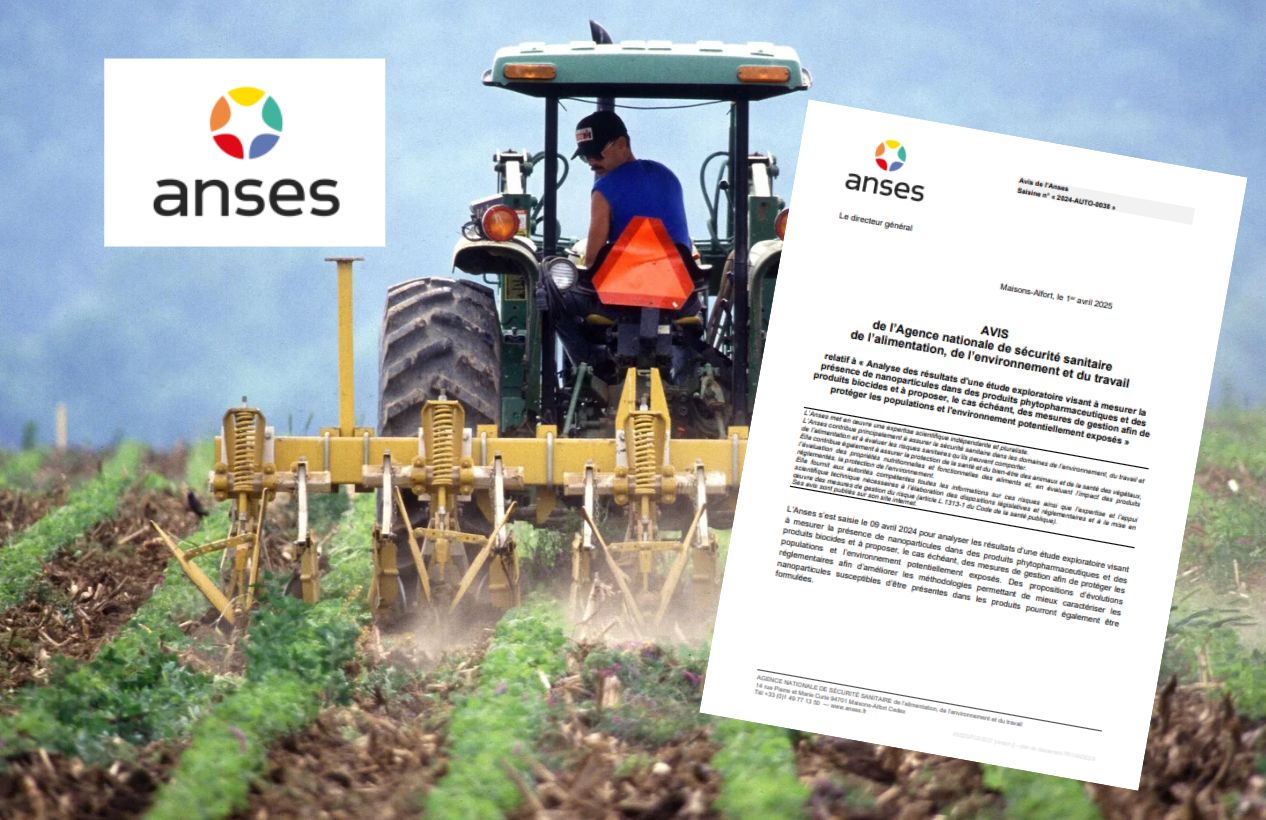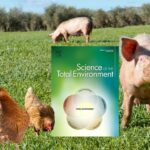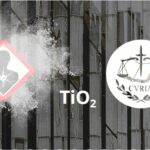
There are nanos in phytopharmaceuticals… but no regulatory framework for them!
Agriculture is among the main sectors using nanos declared in the French r-nano register. In 2016, ANSES sought to find out more and questioned the phytopharmaceutical industry. It then took several years to have more than thirty products tested by the French national laboratory for metrology and testing (LNE). Four years after these tests were completed, the results of these investigations have just been published – at last! 32 of the 33 products tested contained particles smaller than 100 nm. The ANSES opinion published yesterday confirms what other stakeholders, including AVICENN, have been calling for for years: a change in regulations to better identify, assess and manage nanoparticles present in plant protection products, whether in active substances or co-formulants.
At the origin of the survey: agriculture tops the list of use sectors declared in r-nano
Since the creation of the French r-nano register, agriculture has been the leading sector for the use of nanoparticulate substances declared in the r-nano register. Several thousand declarations each year: this, in addition to the numerous publications on the promises of nanos in the agricultural sector, required ANSES to take a closer look…
In 2016, an ANSES mail survey
The agency did send a letter to nearly 1,000 companies in 2016. At the time, it received only a hundred responses, from which it emerged that no active substance was allegedly in nanoparticulate form: according to respondents, only co-formulants were potentially nanos1Without, however, the market authorization holders formally certifying this, with tests to support it..
In 2020, 33 products under the LNE microscope
To get to the bottom of this – and with no clarification provided regarding the reasons for such a lengthy delays – ANSES finally called in the Laboratoire National de Métrologie et d’Essais (LNE) to test some thirty plant protection and biocidal products for nanoparticle content.
The LNE study, provided as an appendix to the ANSES report, was finalized in January 2021 and then subjected to a long… very long analysis by ANSES. It took over four years (!) to publish the results yesterday on its website. They are summarized below:
Of the 33 tested, 32 contained nanos
The official report states that some twenty plant protection products were tested for the presence of nanoparticles, along with ten biocidal products.
→ This is therefore a sampling of products for an exploratory study, and not an exhaustive analysis of all plant protection and biocidal products on the market. These results do, however, enable us to improve our knowledge of the subject, by verifying in very concrete terms what until now has been based solely on declarations – with a presumption of “over-declaration” from companies producing or selling pesticides2Cf. the comments of Charlotte Grastilleur, Deputy Director General in charge of the Anses “regulated products” division, reported in Actu Environnement in March 2024, relating a phenomenon of“over-declaration” in recent years, “by anticipation [in the absence of regulations or restrictions on declarative rules, Editor’s note] or by excess”..
With the exception of one biocide product, all the products tested contained nanoparticles:clay – kaolin / silica (fillers);magnesium and aluminum silicate (sepiolite/halloysite fibers, also fillers) / titanium dioxide (colorant) / copper (active ingredient)…
While the proportion of nanoparticles varies according to product type and composition, these results confirm the urgent need to take a serious look at the subject.
[Don’t look for the names of these products: they do not appear in the ANSES report and have been redacted from the LNE report in the appendix].
A “high degree of uncertainty” about exposure and the dangers associated with nanoparticles
ANSES points out that the results obtained cannot be extrapolated to the residues of these products during and after application: during spraying and once on plants and in the environment, the substances may be subjected to various phenomena (heat, dilution, notably by the impact of precipitation, evaporation) likely to modify the shape of the particles. As a result, “there is considerable uncertainty as to the exposure of people and ecosystems, and the hazards associated with these nanoparticles.”
What measures can be taken to protect workers?
ANSES recalls the preventive measures likely to reduce exposure of operators/users during product use:
– collective protection measures (ventilation of premises)
– and personal protection measures (respiratory protective equipment, protective clothing against chemical risks, disposable hooded coveralls with tightening at the neck, wrists and ankles, without cuffs or turn-ups, double pair of butyl, vinyl or nitrile gloves, shoe covers, etc.).
ANSES recommends a specific framework for nanos in plant protection regulations
While Regulation No. 528/2012 on biocidal products (which does not concern pesticides or fertilizers) contains specific provisions for nanomaterials, Regulation No. 1107/2009 on plant protection products does not.
→ ANSES therefore recommends minimizing the nanoparticles likely to be present in plant protection products – both active substances and co-formulants. It adds: “minimizing exposure at source is a relevant approach given the high uncertainty about nanoparticle exposure levels and the complexity of risk assessment methodologies, particularly for the environment”.
ANSES will advocate to the European Commission, Member States, the European Chemicals Agency (ECHA) and the European Food Safety Agency (EFSA) for the integration of the methods recommended in the current regulation on chemical substances (REACH regulation) into the test requirements to be submitted under the regulation on plant protection substances and products3See our Infosheet What framework for nanomaterials under REACH?.
NGO reactions
AVICENN, which obtained the Innovamol report “Collection and review of information on nanomaterial-based and nanoenabled plant protection products, biocidal products and fertilizing products” from ECHA, published last November, is pleased to see that the recommendations of ANSES and the researchers who have worked on the subject are converging…. even if we find it hard to understand why it has taken so long to publish this report4We have asked ANSES several times, during the “nanomaterials and health” dialogue committee in which we participate, why the results have not yet been published… without ever receiving an answer on this point..
Our association has also gathered the reactions of the NGOs among its members who are mobilized on the issue of pesticides in France. They also support the ANSES recommendations:
– Nadine Lauverjat, from Générations futures, welcomes “this important step forward”, but also sees the published results as “a warning signal: as long as regulatory requirements do not cover active substances and co-formulants prior to formulation, nanoparticle detection will remain partial, risks poorly assessed, and protection inadequate“. It calls for “application of the precautionary principle: the reduction of exposure to nanoparticles at the source must become the standard, not the exception”.
– Stéphen Kerchove, from Agir pour l’Environnement, also considers it essential to “review marketing authorization procedures: at present, they overlook the inevitable effects of nanoparticles on the environment and health”.
AVICENN will seek input from other players working on nanomaterials and/or pesticides and fertilizers, and will take part in the next meeting of the ANSES “nanomaterials and health” dialogue committee, where the report will be presented on June 27.
To be continued…

More information in our sheets
Other nano-related news
Next nano events

- Webconference for analysis laboratories, plant fertilizer manufacturers and distributors, public authorities…
- Moderated by David Krupka, nanotechnologies development manager at AFNOR Normalisation and Emilie Langlois-Bertrand, nantechnologies standardization project manager.
- In partnership with Armand Masion, CNRS Research Director, and Sandrine Mocoeur, Health, Safety, Environment and Quality Manager at SYNGENTA.
- This exchange will also be an opportunity to explore the creation of a national platform to identify standardization needs.
- Website: www.afnor.org/evenement/nanotechnologies-agriculture-cadre-pratique-responsable/
- 8th Congress of Occupational Medicine and Health (CNMST 2026)
- Theme 5: Emerging pathologies and risks, Mr Henri Bastos (ANSES), Pr Lynda Bensefa-Colas (AP-HP), Dr Catherine Nisse (CHU Lille)
- Website: www.medecine-sante-travail.com
- 20th meeting of the “nano and health” dialogue committee
- Organizer: ANSES
Notes and references
- 1Without, however, the market authorization holders formally certifying this, with tests to support it.
- 2Cf. the comments of Charlotte Grastilleur, Deputy Director General in charge of the Anses “regulated products” division, reported in Actu Environnement in March 2024, relating a phenomenon of“over-declaration” in recent years, “by anticipation [in the absence of regulations or restrictions on declarative rules, Editor’s note] or by excess”.
- 3See our Infosheet What framework for nanomaterials under REACH?
- 4We have asked ANSES several times, during the “nanomaterials and health” dialogue committee in which we participate, why the results have not yet been published… without ever receiving an answer on this point.



